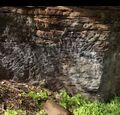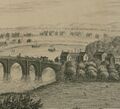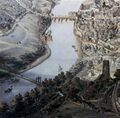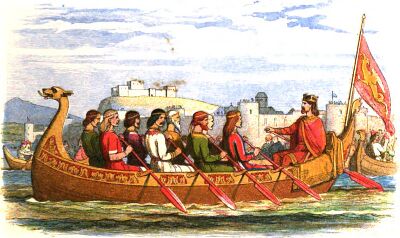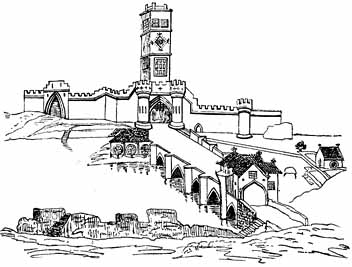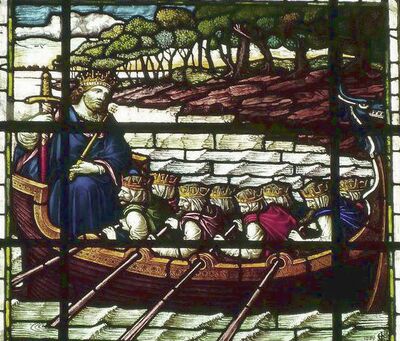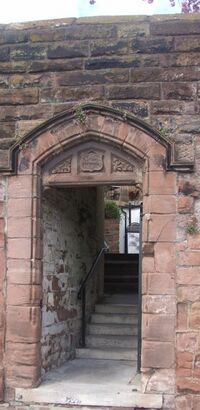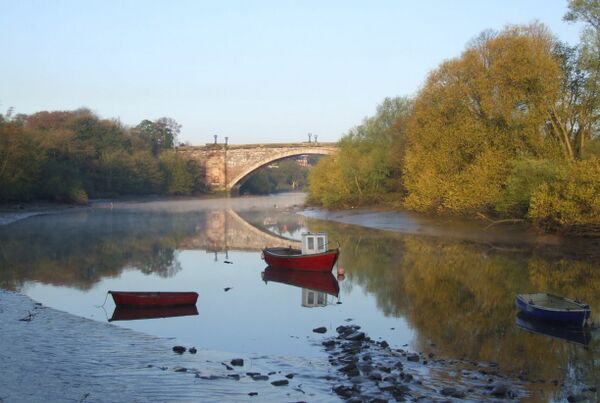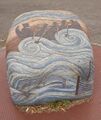Edgar's Field

Edgar’s Field is a smallish public park at the south end of the Old Dee Bridge which was given to Chester by the then Duke of Westminster in 1892. The park is named after King Edgar, who in 973, is supposed to have been rowed up the River Dee by eight British princes. Hemingway writes of it:
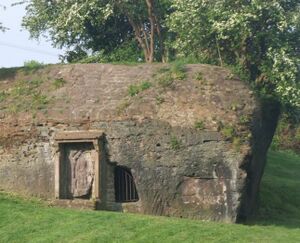
- "In a field on the right of Handbridge called Edgar's Field is an ancient piece of sculpture supposed to be intended for the figure of Pallas the Dea armigera of the Romans. The goddess appears in her warlike dress with her bird and altar. Adjoining this figure is a considerable indention in the rock to which tradition has given the name of Edgar's cave. The sculpture is certainly of great antiquity being noticed by Malmesbury who wrote in 1140, by Hoveden in 1192, by Selden, Camden, the Polychronicon, and the Saxon Chronicle and Dr Cowper in a note on his II Penseroso about 1747 says The foundations of his Edgar's princely mansion are now apparent just below Chester bridge southward. Beyond this several centuries ago stood some ancient buildings whose site is marked by certain hollows for says Pennant who wrote about 1778 the ground probably over the vaults gave way and fell in within the remembrance of persons now alive. Tradition calls the spot the site of the palace of Edgar. Nothing is now left from which any judgment can be formed whether it had been a Roman building as Dr Stukeley surmises or Saxon according to the present notion or Norman according to Braun who in his ancient plan of this city styles the ruins then actually existing Ruinosa damns Comitis Cestriensis. Perhaps it might have been used successively by one of them who added or improved according to their respective national modes."
Nowadays the field is home to a park, an impressive Roman remnant and a very clever bit of sculpture - all often overlooked by visitors to Chester..
The Roman Quarry
The second fortress of Roman Chester was constructed of local sandstone, which was quarried from across the river to the south of the fortress. Traces of the quarry can still be seen today at Edgar's Field in Handbridge. A large amount of sandstone was taken and used in the construction of the fortress wall and the many buildings inside. On the old quarry face, near an old ford, was carved an image of the Roman goddess Minerva (see "Minerva Shrine"). A cave is cut into the rock face behind the figure and forms a shrine for votive offerings. This is known as Edgar's Cave. The rock outcrop bearing the carving and cave are now surrounded by a park with a childrens' playground in the centre and the grass around the monument is cut as a lawn. An area of the floor of the quarry is also included. The relief sculpted figure, which is also Listed Grade II, stands 1.45m high and 0.73m wide. It has been enclosed by a sandstone frame which originally held a steel gate across the front of the sculpture to protect it from vandalism. To the right of the frame, the cave is cut into the rock face; to the left it is built up with freestone to support it from behind. The entrance to the cave is now closed with a steel grill. The top of the rock face has been capped with stone setts.
Minerva may have been carved by the workmen of the quarry for protection. Excavations in the early 1920s revealed that the quarry was in use c.100 AD. Soil was imported to cover the quarry floor in the late-second century AD. Roman occupation remains dating from that time on were found on the site. Subsequently stone was quarried from the site again during the Middle Ages. The sculpted shrine and figure of the goddess would appear to have been carved during the working of the quarry. It may have been adopted as a Christian shrine in later centuries which would account for the remarkable preservation of the figure and its surround. Chisel marks can be seen on the rock face next to the shrine.

There are some Roman cut sandstone slabs and blocks near the play area in the park. These sandstone blocks were discovered on Roman sites in the City of Chester during extensive rebuilding works in the 1960's and 1970's. The stone would have been quarried from the extensive Roman quarries at Edgar's Field. They are plainly dressed, with the Roman chisel marks still visible, and would have come from the foundations of large Roman buildings inside the fortress of Deva. Some preliminary archaeological trenches were dug in the park in December 2009 to investigate the extent of archaeology in the area, prior to a major refurbishment. A small foundation was found that requires further recording, investigation and characterization.
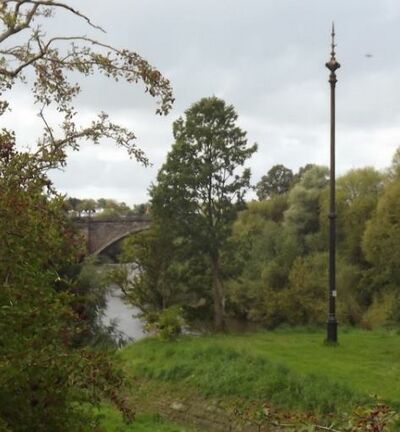
Gallery of Edgar's Field
The Minerva Shrine in 2017..
Edgar (16) and his field by the Buck bros (1728).
One plant found growing in the park is "Spotted Medic" (Medicago arabica) a flowering plant of the family Fabaceae. It has a small yellow flower and distinctive dark, purplish patches on the clover-shaped leaves. The plant propogates by burr-covered seed pods. It is native to the Mediterranean basin but is now found throughout the world. It was possibly brought to Britain by the Romans as a medicinal herb. It forms a symbiotic relationship with the bacterium Sinorhizobium medicae, which is capable of nitrogen fixation. The leaves and roots of Spotted Medick are reported to contain biologically active terpene saponins with antibacterial and antifungal properties. These are related to hederagenin, which may have antidepressant-like effects, but the plant is also known to contain hemolytic toxins. There has also been interest in these saponins as a valuable natural resource exploitable in the medical and food industry for ameliorating type 2 diabetes, obesity, metabolic syndrome and inflammation, and to control the causal agent of Cephalosporium stripe disease of winter cereals. However the "Medic" part of the name has nothing to do with medicine - the genus name is based on the Latin name for that plant, medica, from Greek: medike: meaning a grass from Media in north-western Iran, best known for having been the political and cultural base of the Medes and other ancient Iranian people.
The conspicuous "Weathervane" on what is often called "Weathervane Hill" is acutually a sewer vent pipe as well as a weathervane. There are similar vent pipes in Curzon Park North and between the Grosvenor Park and St Johns Church. There is another at the junction of Filkins Lane and Chapel Lane (next to the boundary stone in Boughton) and yet another at the end of each of Cornwall, Talbot and Walter Streets in Newtown. The vents are the openings in the "diver's helmet" at the top.
Edgar
Edgar the Pacific, (c. Aug 7, 943 – July 8, 975) was the great-grandson of Alfred and was famously crowned both at Bath and at Chester (in 973) as the first king of all England. The religious rites used in his coronation (use of anointing etc.) were devised by St. Dunstan and have been in use ever since. King Edgar is said to have prayed in the minster (monasterium) of St Johns after being rowed along the River Dee. The rather fanciful illustrated tiles at the Bull and Stirrup in Chester show this event set against the backdrop of much later-built city walls. In common with his brother Edwy and others of his predecessors in the House of Wessex, Edgar was a very small man, recorded as being less than five feet tall, unlike the figure shown in the illustration. William of Malmesbury, reporting on Edgar's slightness of height and build, records that at a banquet that followed the meeting at Chester, Kenneth, King of Scots, commented jokingly that it seemed extraordinary to him how so many provinces should be held by "such a sorry little fellow."
Although Edgar the Pacific (959–975) did much to consolidate a fractured and factional Anglo-Saxon island, including his famous meeting at Chester at Edgar's Field on the Dee, the country remained troubled. The AS Chronicle records the meeting thus (versions again vary):
- A.D. 972. This year Edgar the etheling was consecrated king at Bath, on Pentecost's mass-day, on the fifth before the ides of May, the thirteenth year since he had obtained the kingdom; and he was then one less than thirty years of age. And soon after that, the king led all his ship-forces to Chester; and there came to meet him six kings, and they all plighted their troth to him, that they would be his fellow-workers by sea and by land.
According to the eventual legend, Edgar was rowed upriver to St Johns Church where he was crowned, but there is no mention of rowing in the ASC.
The Victorian "Picturesque England" has a different slant on the story, commenting that:
- "He ascended a large vessel, with his nobles and officers, and stationed himself at the helm, while the eight kings who had come to pay him homage were compelled to take the seats of the watermen, and to row him down the Dee - a most arrogant insult on the feelings of others whose titular dignity was equal to his own. Edgar crowned the scene, and consummated his disgrace, by declaring to his courtiers that his successors might call themselves kings of England when they could compel as many kings to give them such honour."
Thus, later chroniclers made the kings into eight, all plying the oars of Edgar's state barge on the River Dee. Such embellishments may not be factual, and what actually happened is perhaps unclear.
Who were the kings?
Florence of Worcester (died 1118) disagrees with the ASC and provides the source for the count of eight kings:
- "Eight petty kings, namely, Kynath, king of the Scots, Malcolm, king of the Cumbrians, Maccus, king of several isles, and five others named Dufnall, Siferth, Huwall, Jacob, and Juchill, met him there as he had appointed, and swore that they would be faithful to him, and assist him by land and by sea."
Florence's assertion that there were eight kings is substantiated by Ælfric of Eynsham who, in his 'Life' of St.Swithun (written in the 990s) states:
- "... and ealle ða cyningas þe on þissum iglandewæron, Cumera and Scotta comon to Eadgare, hwilum anes dæges eahta cyningas and hiealle gebugon to Eadgares wissunge (and all the kings who were in this island, of the Cymry and Scots, came to Edgar, eight kings once upon a day, and they all submitted to Edgar's rule)."
Just who all these kings are presents something of a puzzle. These kings are identified (M Westm 375) as follows:
- "Kenedo scilicet rcge Scotorum, Malcolmo Cumbrorum, Macone rege Monae et plurimarum insularum, Dufnal rege Demetiae, Sifertho et Howel, regibus Walliae Jacobo regc Gawallioe et Jukil Westmariae." (Kined king of the Scots, Malcolm of the Cumbrians, Maco king of Man and of very many isles, Dufnal king of Dyfed, Siferth and Hywel kings of Wales, James king of Galloway and Jukil of Westmoreland.)
This listing presents something of a problem as Dyfed did not exist as such in 972. Owain ap Hywel (died 987) was king of Deheubarth in south Wales and probably also controlled Powys. Possibly the truth is something like that given below (although other interpretations are possible):
The Scottish Kings (these are the only ones whose kingdoms are named)..
- Kynath is Kenneth II of Alba b.~954–d.995 (Modern Gaelic: Coinneach mac Mhaoil Chaluim, anglicised as Kenneth II, (and nicknamed An Fionnghalach, "The Fratricide"). The Chronicle of the Kings of Alba was compiled in Kenneth's reign, and states that Kenneth plundered Northumbria three times, first as far as Stainmore, then to Cluiam and lastly to the River Dee by Chester. These raids may belong to around 980, when the Anglo-Saxon Chronicle records attacks on Cheshire. In 973, the Chronicle of Melrose reports that Kenneth, with Máel Coluim I (Máel Coluim mac Domnaill), the King of Strathclyde, "Maccus, king of very many islands" (i.e. Magnus Haraldsson (Maccus mac Arailt), King of Mann and the Isles) and other kings, Welsh and Norse, came to Chester to acknowledge the overlordship of the English king Edgar the Peaceable. It may be that Edgar here regulated the frontier between the southern lands of the kingdom of Alba and the northern lands of his English kingdom. Cumbria was English, the western frontier lay on the Solway. In the east, the frontier lay somewhere in later Lothian, south of Edinburgh.
- Dufnall has been identified with Dyfnwal III (Gaelic: Domnall mac Eógain, English: "Donald") who was the ruler of the Kingdom of Strathclyde. He is styled Domnall m. Eogain, ri Bretan (king of the Britons) in the Annals of Ulster, which notes his death in 975 on pilgrimage. The Welsh source known as the Brut y Tywysogion calls him "Dunguallon", and confirms that Dyfnwal did indeed set off on pilgrimage to Rome.
- Malcolm (Gaelic: Máel Coluim) is possibly Máel Coluim I of Strathclyde, Dyfnwal's son. Presumably, by this time, Dyfnwal had abdicated his kingdom and Malcolm had become ruler of the Kingdom of Strathclyde.
A possible Norse-Gaelic..
- The "several isles" Maccus 'mac Arailt' was king of would be the Isle of Man and the Sudreys (Norse: sudr-eyjar or Southern Isles i.e. the Hebrides and other islands west of Scotland). He appears to have been responsible for a raid on Anglesey a couple of years before the Chester meeting - it has been suggested that Maccus was not actually his given name, but might be misconstrued from the Gaelic 'mac Arailt' i.e. 'son of Harald' - in the B-text of the 'Annales Cambriae' the raider of Anglesey is referred to simply as "filio Haraldi".
The Welsh Kings...
- "Jacob" is almost certainly Iago ab Idwal, then king of Gwynedd. Iago ruled Gwynedd until 979 when he in turn was taken prisoner by Ieuaf's son, Hywel ab Ieuaf, who took over his kingdom. There appears to be no record of Iago's fate.
- Huwall is probably Iago's nephew, and rival, Hywel. In 974 Hywel raised an army and drove his uncle from Gwynedd. Iago was able to return, but was forced to share power with his nephew. In 978 Hywel made another attempt to take the kingdom from his uncle, raiding the monastery at Clynnog Fawr. In this raid Hywel has helped by English troops, possibly provided by Aelfhere, Earl of Mercia. Hywel defeated Iago in battle in 979, and the same year Iago was captured by a force of Vikings, possibly in Hywel's pay, and vanished. However it is also possible that the "Howel" mentioned is Owain ap Hywel king of Deheubarth in south Wales and possibly Powys.
- Juchill/Ithel (from the Welsh elements iud "lord, prince" and hael "generous") could possibly be Morgan the Old (Morgan Hen or Morgan ab Owain or Moragn Hen Fawr) (b930-d974) who united the former kingdoms of Gwent and Glywysing in 942 under the name of Morgannwg (Glamorgan). It is possible also that this was someone else and that the name is a misconception based on the person's title.
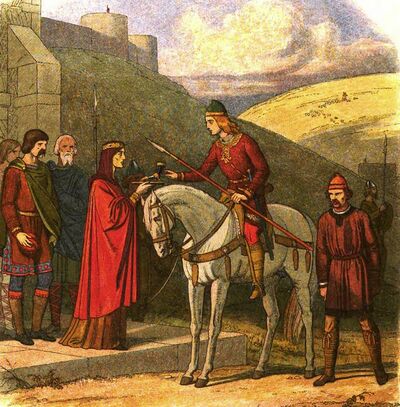
And finally..
- Siferth is a difficult one - but could be another Viking/Dane
Florence continues:
- "On a certain day they [the "eight petty kings"] attended him [Edgar] in a boat, and when he had placed them at the oars, he himself took the helm and skilfully steered it down the river Dee, and thus, followed by the whole company of earls and nobles, in this order went from the palace to the monastery of St.John the Baptist. After having prayed there, he returned with the same pomp to the palace."
What happened next?
Following the boat trip in 972:
- Edgar died "suddenly" in 975 (at the age of 32/33 - the cause is unknown) and was succeeded by Edward the Martyr his eldest son (possibly aged 13). Edward was king of England from 975 until he was murdered in 978 (possibly aged 16). He is thought to have been the son of King Edgar and his first wife Æthelflæd. His succession to the throne was contested by supporters of his half-brother Æthelred, but with Dunstan's support, Edward was acknowledged by the Witan and crowned king by Dunstan and Oswald of Worcester. Edward's reign began inauspiciously when a comet was sighted. A famine followed. His reign was short and disturbed by factional strife. He was supposedly killed at Corfe Castle (which dates from much later), possibly by servants of his stepmother the Queen Dowager Ælfthryth (Elfrida) on 18 March 978. Ethelred II (The Unready), the son of Edgar the Peaceable by his second marriage to Elfrida, succeeded to England's throne at ten years old and was crowned with due ceremony on 14th April, 978.
- Kynath was raiding as far south as Cheshire by 980.
- Dufnall died in 975 on pilgramage to Rome.
- Malcolm ruled until 997, uneventfully.
- Maccus, in 974, according to the eleventh–fourteenth-century Annals of Inisfallen and the Annals of the Four Masters, accompanied by the lagmainn ("lawmen") of the Isles—attacked Scattery Island and captured Ímar, King of Limerick (died 977). It is possible Maccus was dead by 980 or 984.
- Jacob (Iago) was usurped by Ieuaf's son Hywel (Huwall) in 979. There appears to be no surviving record of Iago's fate.
- Huwall (Hywel) as noted, usurped Jacob in 974. In 978 English troops possibly supplied by Ælfhere of Mercia are deployed on the Lleyn Peninsula on behalf of King Hywel ab Ieuaf of Gwynedd in order to prevent his uncle, Iago, invading with Viking allies from Dublin.
- Morgan the old died in c974. By 983 Mercian Earl Ælfhere was campaigning against Brycheiniog and Morgannwg, with the aid of the Welsh king Hywel. After the killing of Edward by Ælfthryth's servants in 978, Ælfhere supported the new king, Ælfthryth's son Æthelred the Unready, and was the leading nobleman in the Kingdom of England until his death in 983.
- As for the last one the AS Chronicle records that Vikings ravaged Chester in 980, doing great damage: "the county of Chester was plundered by the pirate-army of the North". Three of the four Anglo-Saxon coin hoards found in the city, those from Castle Esplanade, Pemberton's Parlour, and Eastgate Street, have been assigned to roughly the same period and interpreted as linked to that raid.
So within a few years the "kings" had mostly died or fallen out and were fighting each other (or their successors). There is some uncertainty over exactly who killed Edgar's son in 978. It could have been agents of his step-mother Ælfthryth, supporters of Ælfthryth's son Edward, agents of Ælfhere of Mercia (who appears to have been related to Ælfthryth) or even some combination of the same who were concerned over Edward's frequent outbursts of rage. What is certain is that within a few years of Edgar's celebrated trip up the River Dee the monarchy was in a oomplete mess.
The Palace of the Earl
Both the Braun and Hogenberg map of Chester (from around 1581) and later maps shows "ruin of the house of the count of Chester" by the River Dee in Edgar's Field (also known as "Kettle's Croft" prior to 1892), close to the location of Minerva Shrine. In 973, the Anglo Saxon Chronicle records that, two years after his coronation at Bath, King Edgar of England, came to Chester where (according to Florence of Worcester - writing around 1100) he held his court in a palace, which tradition holds was in a place now known as Edgar’s field near the old Dee bridge in Handbridge:
- "On a certain day they [the "eight petty kings"] attended him [Edgar] in a boat, and when he had placed them at the oars, he himself took the helm and skilfully steered it down the river Dee, and thus, followed by the whole company of earls and nobles, in this order went from the palace to the monastery of St.John the Baptist. After having prayed there, he returned with the same pomp to the palace."
Of course there was no weir at that time, so Edgar would not face the problems that would occur in repeating the journey today.
It is curious that there should be two "palaces" associated with the same spot, and it seems odd that the Earl should have his palace located outside of the walls of the city. It is possible that the two have been confused, with the later Earl's palace being assumed to be that of Edgar. Edgar's Field was laid out as a public park (and renamed from "Kettle's Croft") by the first Duke of Westminster, Hugh Lupus Grosvenor who presented it to the City of Chester in 1892 as one of the family's many philanthropic activities.
Thomas Bradshaw's description of King Edgar's trip up the Dee differs from the usual legend as it has Edgar starting his journey on the city side of the river:
- "From the Castell he went to the water of Dee, By a priue porsturne through walles of the towne, The kyng toke his barge with mycle rialte, Rowyng upwarde to the churche of saynt John, The forsyd viii kynges with hym went alone, Kynge Edgar kept the storne, as most principall, Eche prince had an ore to labour withall."
One problem with this version is that there was no Chester Castle at the time.
There are also what appear to be ruins of a building in the foreground of Randle Holme's sketch, these are marked on the map as the "ruins of a chapel". Could this chapel have stood on the site of the former palace or, perhaps, beem constucted of stone robbed-out from it. Or is it even possible that Edgar never had a palace here, but that it was elsewhere? Note that the earlier sources both say that Edgar was rowed "down" the River Dee. It has been suggested that there was a royal palace at Farndon. Two medieval sources describe Farndon as a ‘royal town’; Edward the Elder, king from 899, died there in AD 924 and it is also apparently documented that Edgar, Edward's grandson, was rowed along the River Dee from his palace at Farndon to Chester (Dodgson 1972, 74-5, 119, 124). The settlement plan at Farndon, however, is more reminiscent of a monastic site and it is possible that since Farndon originally included Aldford, that the royal centre was located there instead.
Thomas Pennant writes of the area around the Minerva Shrine:
- "Beyond this stood past all memory some antient buildings whose site is marked by certain hollows for the ground probably over the vaults gave way and fell in within the remembrance of persons now alive. Tradition calls the spot the site of the palace of Edgar. Nothing is now left from which any judgment can be formed whether it had been a Roman building as Doctor Stukeley surmises or Saxon according to the present notion or Norman according to Braun who in his antient plan of this city styles the ruins then actually existing "Ruinosa domus Comitis Ceftrients". Perhaps it might have been used successively by every one who added or improved according to their respective national modes."
Edgar's Field was initially proposed as the location for the Chester Leadworks, which would have probably resulted in the destruction of the Minerva Shrine. Fortunately, the Leadworks proposed site was moved to Canalside, where the "shot-tower" (a notable Chester landmark) was constructed in 1799.
The King's Pool
The area below the weir and around the Old Dee Bridge is now known as the "King's Pool". However, before the earldom of Chester passed to the Crown in 1237 it was called the Earl's Pool. A fishery developed at this location because since (prior to the construction of the salmon steps) fish could only pass over the weir at high tide - all fishing in the Dee at Chester was under the control of the Earl. This was an excellent spot for salmon fishing.
The River Dee is recognised as one of North Wales’ premier rivers for Atlantic salmon (Salmo sala). The Mynach, Meloch and Ceiriog tributaries are the most important salmon spawning tributaries in the Dee catchment and are included in the Afon Dyfrdwy-River Dee SSSI and also in relation to the English part of Ceiriog in the River Dee (England). Other migratory fish utilising the river system include sea trout (Salmo trutta trutta), eel (Anguilla anguilla), river lamprey (Lampetra fluviatilus), and sea lamprey (Petromyzon marinus). Joseph Hemingway, writing in 1835, noted:
- "In that useful article, salmon, no market in the kingdom did, some few years ago, excel it; indeed, such was the profusion of that valuable fish, that masters were often restricted, by a clause in the indentiture, from giving it more than twice a week to their apprentices. Though the bounty of providence, in this particular, is yet unabated, such restriction is no longer necessary- some artificial cause, or other very kindly, rendering this fish, at the present day, a delicacy even to the masters themselves... The supply was so great, that after furnishing our own market for the city and neighbourhood, five or six carts were employed in conveying it for sale to distant places"
The earliest unquestioned record of the fishery at Chester itself is the grant by Ranulph De Gernon (1129–53) of a tithe of the profits from the fish taken at the Dee Bridge. Thereafter the earl granted favoured religious houses such as Calke (Derb.), Garendon (Leics.), and Chester nunnery rights to fish in the Dee above or below the bridge. The monks of Wenlock (Salop.), in particular, were allowed to fish wherever they wished downstream of the bridge or upstream to Eaton, using seine nets, stall nets, and float nets, and were given a house in which to maintain a fisherman to man their boat.
Such grants were continued by Hugh de Kevelioc (1153–81), to the communities of Bordesley (Worcs.) and Trentham (Staffs.). Under Hugh de Kevelioc and Ranulf de Blondeville (1181–1232) fishing rights were also extended to laymen, including officers of the earldom such as Roger the constable and Peter the clerk, tenants such as Robert Lancelyn, and citizens of Chester such as Nicholas son of Robert and Andrew son of Mabel. The right to maintain a boat on the Dee was hereditary; that granted to Peter the clerk, for example, had descended by the 14th century to his great-grandson Peter Thornton. It was also alienable, for c. 1270 such a right was granted by Stephen, son of Richard the fisherman, to his sister Ellen. By the 14th century named fisheries were established in the river, such as 'Mabbes stalls' at Portpool, to which four nets were attached.

By the late Middle Ages the fisheries were policed by the serjeants of the Dee and by the mayor and corporation, whose role as conservators, confirmed by the 1506 charter, eventually made the serjeants redundant. Fish continued to abound in the river until the early 19th century. By 1830, however, when the fisheries were worked by c. 32 rowing boats, numbers were down and prices had risen, allegedly because of the netting of young fry with small-meshed nets and the netting of the millrace at the weir. There are some rough carvings of river boats, now much faded, with triangular sails, incised into the coping stones of the wall between Edgar's Field and the river, and the 2010 upgrade of the park facilities included new railings including metal fish.
In 1866 the River Dee Fishing Board was established with powers to protect the salmon fisheries through licensing and the establishment of a hatchery. A fish pass at the weir, first proposed in 1869, was built in 1913 or 1914 by agreement between Chester corporation, the River Dee Fishing Board, and the owners of the weir. It comprised a 'ladder' of four broad pools, constructed parallel with the weir at the Handbridge end. Herons, Cormorants and other diving birds congregate at the lower end of these "Sakmon Steps" at the appropritate time of year. The fortunes of the fisheries varied in later years. The 1920s were generally good, the 1950s relatively poor. From the 1970s there was a decline in the numbers of fish caught, though there were signs of improvement in the 1990s.
In recent years the river has suffered a number of pollution incidents, including one in July 2000 when 100,000 fish suffocated, but the source of that leak was never traced.
Modern Sculpture
The field is also home to the award winning 2010 mosaic scuplture by Gary Drostle called "Time’s Hand". The sculpture comprises a mosaic covered block surrounded by the words "PRIMEVAL DESERT. RIVER CUT. ROMAN CHISEL. TIME’S HAND FORMS OUR SPACE." The upper surface of the block carries a depiction of Edgar in a boat, while around the sides are swirling waters, the Old Dee Bridge, the Minerva Shrine, chisel marks on rock, some fish nets, fish, leaping salmon, and some fossil footprints. Gary Drostle's signature is hidden in one of the salmon - as is a ring from the song "one in a million" by Chris Wood. The "fish story" is that of Polykrates, the biblical Solomon recovers his signet ring in a similar manner, there are many other stories of "The fish and the ring" but in the majority of them it is a salmon which swallows the ring. One notable tale is that of St Mungo: which refers to the story about Queen Languoreth of Strathclyde who was suspected of infidelity by her husband. King Riderch demanded to see her ring, which he claimed she had given to her lover. In reality the King had thrown it into the River Clyde. Faced with execution she appealed for help to Mungo, who ordered a messenger to catch a fish in the river. On opening the fish, the ring was miraculously found inside, which allowed the Queen to clear her name. This story may be confused with an almost identical "local" one concerning King Maelgwn of Gwynedd and Saint Asaph.
The artist has kindly confirmed that footprints are those of the creature called "Chirotherium" ("hand-beast"), because of their resemblance to human hands. These were found in Triassic sandstones from Germany in 1834 and in a quarry at Storeton, Wirral in 1838. As no bones or other fossil remains were found at either locality, the trackmaker's identity was initially a mystery. At first it was thought to be an ape or bear crawling with its hands crossed, so that the thumb appeared on the outer side. The print’s resemblance to mammals was only superficial; in reality, an external (lateral) ‘thumb’ was commonplace among Triassic archosaurs. In 1842 Richard Owen confidently identified the prints as those of labyrinthodont amphibians. Owen is best remembered today for coining the word Dinosauria (meaning "Terrible Reptile" or "Fearfully Great Reptile"). Later discoveries at the Higher Bebington White Freestone Quarry on the Wirral and elsewhere indicated that the trackmakers were more likely to have been pseudosuchian reptiles. In 1965 strong confirmation of this view came from the discovery in Switzerland of the skeleton of Ticinosuchus ferox. The absence of fossil remains associated with the footprints has always been ascribed to the arid climate of Triassic times – a view reinforced by Henry Charles Beasley in 1907. A more moderate viewpoint was put forward by George Highfield Morton in 1898, who took note of the traces of flora found in the local Triassic strata. Pictorial representations through the late nineteenth and twentieth centuries indicate varying interpretations of the degree of aridity from sparsely vegetated landscapes to sand sea desert. Recent work has showm that the middle Triassic environment - between 247.2 Ma and 237 Ma (million years ago) - was more richly vegetated and humid than had previously been supposed, and that the historical interpretation of aridity has probably been overstated. At that time, what is now Britain was close to the equator, and Edgar's Field would be in the middle of a massive expanse of sand, with huge dune systems and muddy vegetated water channels: a bit like the river Nile.
Gallery on Time's Hand
Minerva Shrine and chisel marks
The above photo's were taken in September 2017.
Related pages
- Minerva Shrine;
- Old Dee Bridge;
- Grosvenor Bridge;
- River Dee;
- Farndon: another local "royal residence";
- Handbridge;
- Chester Castle;
- Earls of Chester;
- Gary Drostle;
- Ælfgar: the end of the Dark Ages;
- Chester Pageant: recreated Edgar's river trip in 1910;
Sources and Links
- An outing on the Dee: King Edgar at Chester, AD 973;
- Historic England;
- Related charter almost certainly a forgery;
- The "Friends of Edgar's Field";
- Leaflet on Edgar;
- Edgar the Pacific at English Monarchs;
- Time's Hand an interpretation by Prof. Howard M. R. Williams;
- Dinosaurs and Other Extinct Saurians: A Historical Perspective
- Transactions on the Dee: the ‘exceptional’ collection of early sculpture from St John’s, Chester;

